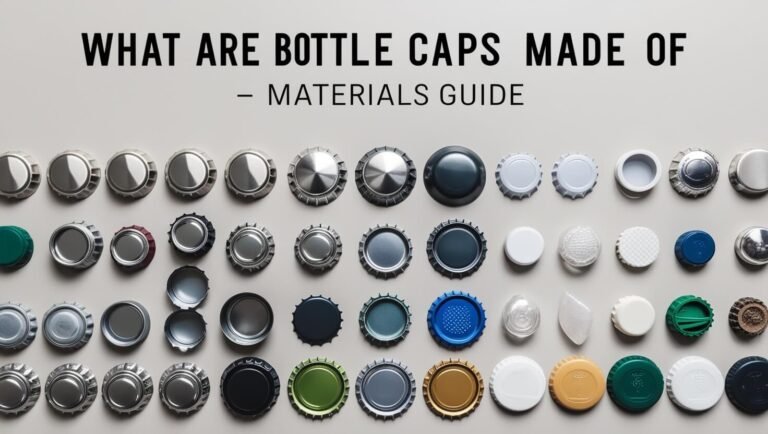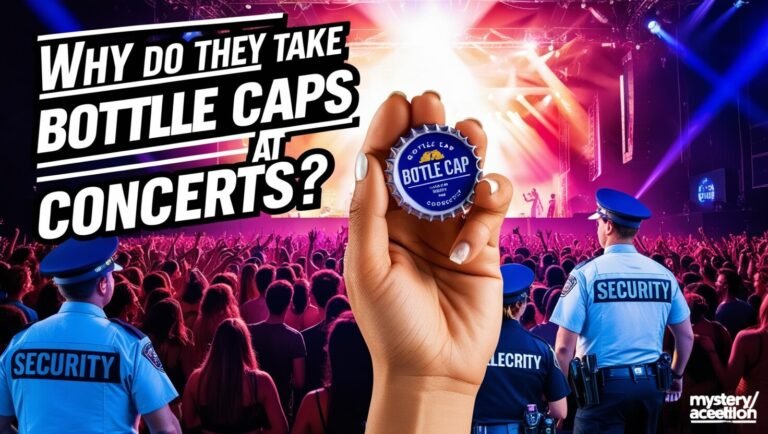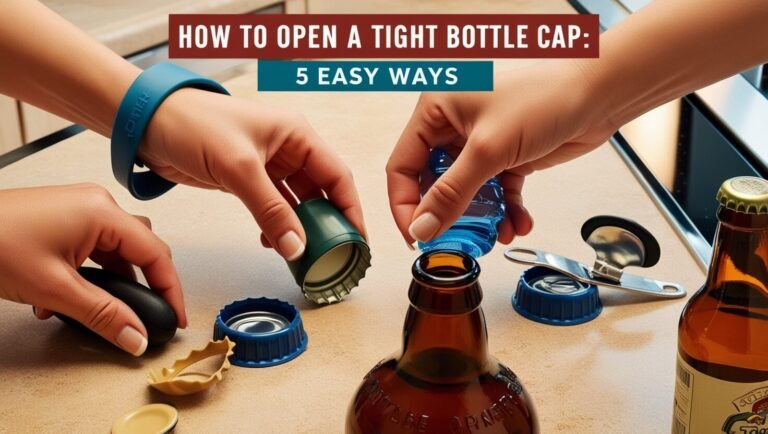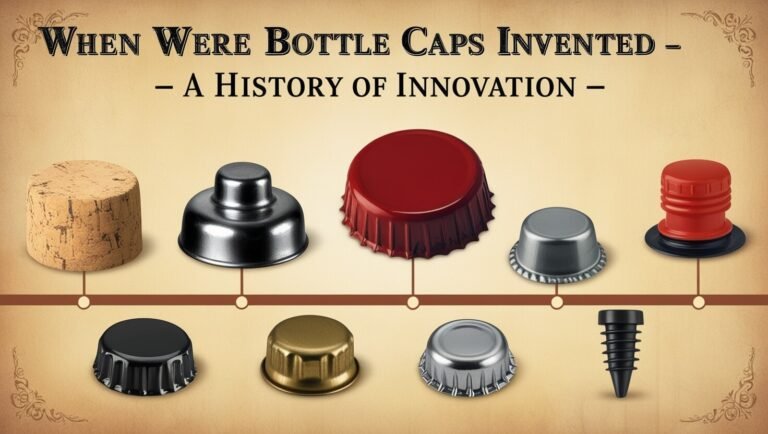Why Do Venues Take Bottle Caps | Safety First
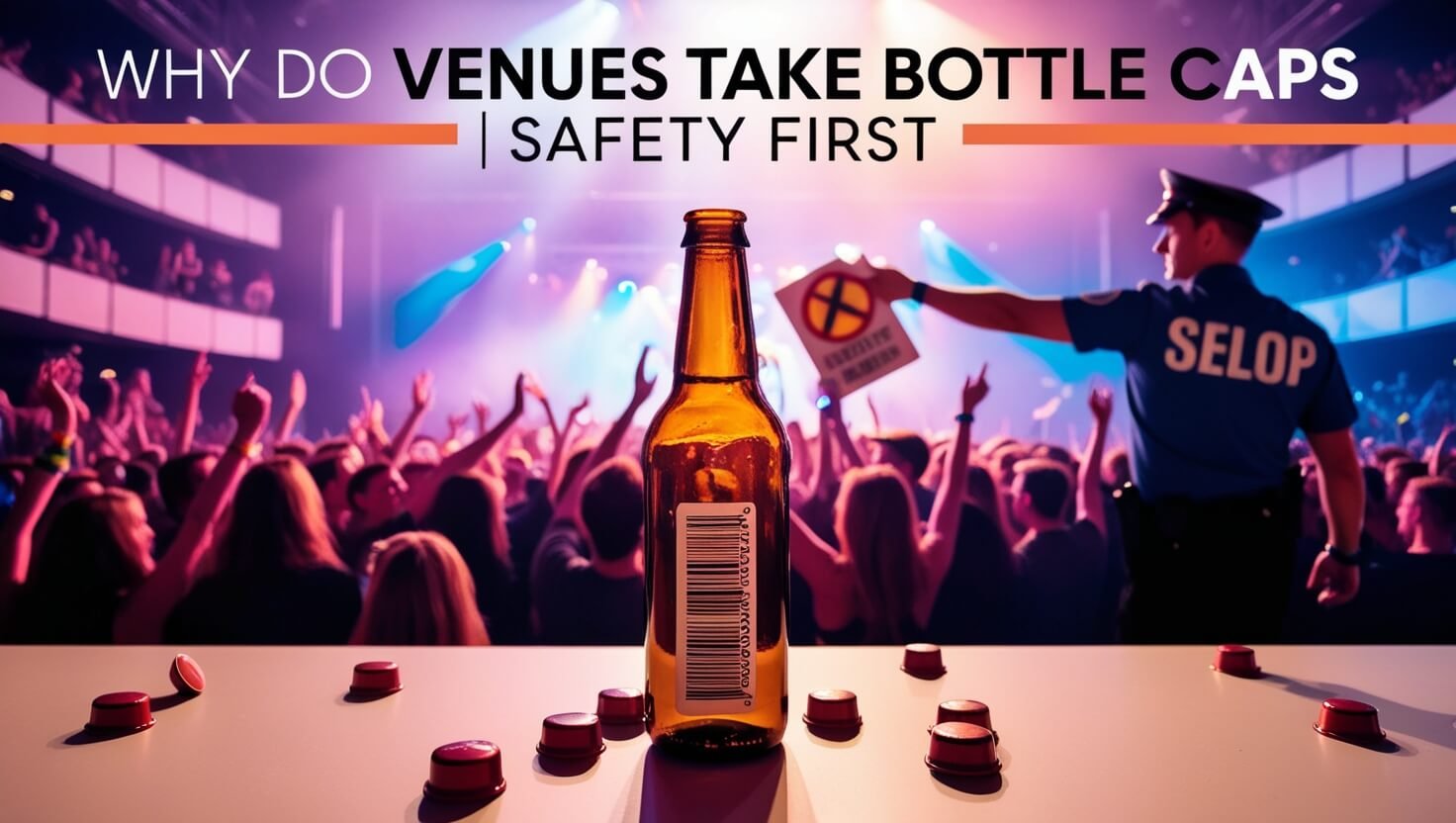
Ever wondered why concert venues and sports arenas take your bottle caps before entry? It’s not just a rule; it’s for your safety. In a world where fan excitement can sometimes get out of hand, venues are taking steps to keep everyone safe.
Imagine if a star like Harry Styles had to stop a show because of fans throwing water bottle caps. Or if people started tossing food, stuffed animals, or phones on stage. These actions not only ruin the show but also put everyone at risk. It’s all about making sure your event is both fun and safe.
The Rise of Venue Safety Protocols
In recent years, concert venues have stepped up their safety game. The tragic loss of 10 lives at Travis Scott’s Astroworld performance was a wake-up call. It showed the need for better safety at concerts and live events.
Evolution of Security Measures
Over time, safety protocols at venues have changed a lot. Events like the Hillsborough Disaster in 1989 and the Camp Randall Crush in 1993 have led to better security. Venues now focus more on crowd management and have stricter entry rules.
Modern Safety Standards
Today, venues face stricter safety standards. They use metal detectors and ban certain items, like bottle caps. They also control alcohol access and prevent underage access to keep everyone safe.
| Year | Incident | Impact |
|---|---|---|
| 1989 | Hillsborough Disaster | 96 lives lost, hundreds injured due to poor crowd management and stadium defects |
| 1993 | Camp Randall Crush | 73 students injured, including 6 critically, following a fence collapse |
| 1996 | Atlanta Summer Olympics Bombing | 1 person killed, over 100 injured, leading to doubled security and surveillance |
| 2004 | Malice at the Palace | 9 players suspended, 5 fans facing criminal charges, prompting new NBA security policies |
| 2011 | Dodgers Stadium Parking Lot Attack | $13.9 million judgment against the Dodgers organization, leading to increased security |
Why Do Venues Take Bottle Caps
Venues often remove bottle caps at live events. This might seem annoying, but it’s for a good reason: safety. They do this to stop caps from being used as projectiles.
Bottles with caps can be dangerous if thrown. The bottle’s weight, the liquid inside, and the tight cap make it a strong weapon. This has caused injuries in the past, like when Bebe Rexha was hit by a phone and Morgan Wallen by a boot.
Removing caps is a way to keep everyone safe. It makes bottles less likely to cause harm. This move is more common after incidents where fans threw things at artists, leading to legal issues and more security.
Some people might find it annoying to have caps removed. They might think it’s a waste of their drink. But, keeping everyone safe is the most important thing. New ideas, like beverage tracking systems and cup-based distribution, are being tried to solve this problem.
Hidden Dangers of Sealed Bottles at Events
At events, a simple bottle cap can be a big risk. Sealed bottles, filled with water, soda, or alcohol, can turn into dangerous objects. Venue managers are now taking steps to prevent these dangers.
Projectile Risk Assessment
Sealed bottles can become deadly when thrown. Their weight and the force used can cause serious harm. This is a big worry in places like sports arenas and concert halls, where things can get out of hand.
Impact Force of Sealed Containers
The force of a thrown sealed bottle is much stronger than open ones. This is because sealed bottles are heavier and more rigid. To keep everyone safe, venues are now banning bottle cap deposit and making sure sealed bottles are thrown away before entering.
Distance and Velocity Concerns
Sealed bottles can travel far and fast, making them even more dangerous. The sealed cap and liquid inside help the bottle stay on course and speed. This means they can hit people from far away, making it important for venues to act quickly.
Celebrity Incidents That Changed Venue Policies
The concert world has seen a big push for venue safety policies and responsible venue management in recent years. This is thanks to famous incidents involving artists and their fans. These events made venues and event planners rethink their security and safety steps.
For example, British pop star Harry Styles had to ban water bottles at his shows. Fans were throwing bottle caps at him, which was dangerous. So, the venue stepped up to keep everyone safe.
“The safety of everyone at our shows is key. We’re working with venues and security to find the best ways to protect fans and the band. We’ll share more on this soon.”
The Astroworld Festival tragedy in 2021, where 10 people died, also changed the industry. It made everyone look closer at crowd management and safety at big events. Now, venues and organizers are making their emergency plans better and adding more safety steps.
These famous incidents showed how vital venue safety policies and responsible venue management are. Artists, event planners, and venue owners are now focusing more on safety. They want to make sure everyone has a good time without worrying about safety.
Bottle Cap Security at Sports Arenas
In recent years, the NBA has made a rule to remove bottle caps from drinks sold inside sports arenas. This rule came after a fan threw a bottle at a player who had taunted the audience. It showed the need for better venue safety policies to protect athletes and spectators.
Now, major sports venues like Boston’s TD Garden, home of the Celtics, enforce this rule. By removing the caps, they aim to prevent bottles from being used as dangerous projectiles. This reduces the risk of injuries from thrown objects.
NBA Safety Regulations
The NBA’s safety rules are to keep players, coaches, and fans safe. Arenas must follow strict guidelines on crowd control, security screening, and concessions. This includes the rule about removing bottle caps.
These bottle cap security measures are now common in professional sports leagues. They ensure fans can enjoy the game safely, without fear of being hit by a flying bottle or object.
Implementation at Major Venues
Major sports venues, from the NBA to the NFL and NHL, have adopted this rule. They work with local law enforcement and security teams to enforce these safety protocols.
The aim is to make the experience safe and enjoyable for everyone. With these venue safety policies in place, fans can cheer on their favorite teams without worrying about dangerous projectiles.
Concert Venue Safety Guidelines
Recently, some concertgoers have thrown objects at performers. To keep everyone safe, concert venues are now enforcing strict safety rules. These rules help prevent dangerous situations and protect both artists and fans.
One key rule is not allowing sealed water bottles or other containers inside. Instead, venues give out open cups or let fans bring empty bottles to fill at water stations. This stops items from being used as weapons and keeps everyone safe.
Venues also watch what fans can bring in closely. They might not let in big bags, backpacks, or certain costumes. These rules help keep the venue safe and prevent any security risks.
| Safety Measures | Description |
|---|---|
| Sealed Bottle Restrictions | Venues ban bringing sealed water bottles or other containers into the event space, providing open cups or allowing empty reusable bottles to be filled at hydration stations. |
| Item Restrictions | Venues restrict certain items, such as large bags, backpacks, and specific types of costumes or props, to enhance overall venue safety. |
| Ticketless Entry | Some venues utilize digital ticketing and contactless entry methods, such as the Ticketmaster app, to streamline the entry process and improve security. |
| Cashless Transactions | Many venues offer cashless or contact-free payment options to reduce the need for physical cash during events, enhance overall safety and efficiency. |
By setting these safety rules, event organizers want to make sure everyone has a good time. They also want to protect the artists who perform. These guidelines help make concerts safe and enjoyable for everyone.
Safety Measures at Music Festivals and Large Events
Music festivals and big events have their own safety challenges. They draw huge crowds. To keep everyone safe, organizers use crowd control and drink distribution rules. These steps help avoid tragedies like the Astroworld concert.
Crowd Management Strategies
Managing crowds well is key at these events. This means controlling how people enter, taking away dangerous items, and doing security checks. Staff watch the crowd, spot trouble spots, and act fast if needed.
Beverage Distribution Controls
Keeping alcohol in check and stopping underage drinking is important. Venues might limit drink buys, remove bottle caps, and ban outside drinks. Some events use cups or water bars to keep people hydrated and watch their drink intake.
| Safety Measure | Objective | Example |
|---|---|---|
| Controlled entry points | Manage crowd flow and prevent overcrowding | Funneling attendees through security checkpoints |
| Confiscation of dangerous items | Eliminate possible projectiles and dangers | Banning umbrellas, folding chairs, and other items |
| Beverage container restrictions | Stop misuse of sealed containers as weapons | Requiring the removal of bottle caps |
| Cup-based distribution systems | Ensure hydration while monitoring consumption | Fabric nightclub in London offers free water through a water bar |
With these safety steps, event planners aim to make sure everyone has a good time. They also work to reduce risks from big crowds and drinking.
Legal Requirements and Venue Liability
Venues must follow strict safety rules and manage risks carefully. Removing bottle caps is a key part of this. These steps help protect everyone at the event, lowering the chance of injuries and lawsuits.
In many places, venues can face legal trouble for alcohol-related incidents. For example, in Florida, a venue might be blamed for serving minors or people who drink too much. Laws usually give venues one to two years to deal with such issues.
To avoid legal problems, venues often ask event planners to get good insurance. This insurance covers many things, like accidents or damage. Venues might also suggest using open bars with limits or giving out a few free drinks to save money.
Venues might also suggest that servers get TIPS certification. This training can help protect them legally in some states. Some venues join programs like Florida’s Responsible Vendors Act. This can help them avoid legal trouble if something goes wrong.
Prioritizing safety and customer happiness makes venues enjoyable. This way, they also reduce the risks of legal and financial problems linked to alcohol.
Alternative Solutions for Drink Safety
Venues are looking for new ways to keep guests safe. They’re trying out cup-based systems where drinks are poured into open cups. This way, they avoid the risk of sealed bottles being thrown.
Cup-based Distribution Systems
Switching to open cups makes venues safer and greener. It cuts down on plastic waste. Guests get to enjoy their drinks without worrying about safety.
Innovative Safety Solutions
Venues are also trying new ideas to keep things safe and easy. For example, the TD Garden in Boston has a walk-through store. Here, guests can buy drinks quickly and easily, without sealed containers.
As the industry grows, venues are tackling the sealed bottle problem head-on. They’re using cups and new ideas to make places safer and more fun for everyone.
| Innovative Safety Solutions | Benefits |
|---|---|
| Cup-based Distribution Systems | -Eliminates the risk of sealed bottles being used as projectiles -Aligns with sustainability efforts by reducing plastic waste -Provides a convenient and enjoyable experience for guests |
| Walk-through Convenience Stores | -Streamlines the beverage purchasing process -Maintains a safe and secure environment for attendees -Offers a modern and innovative approach to venue safety |
Impact on Customer Experience
When venues remove bottle caps for safety, it changes how customers experience things. These rules aim to keep everyone safe and stop misuse. But, they can cause problems like spills and messes.
Venues need to find a good balance. They must keep people safe without making things too hard for customers. It’s important to make sure drinking is easy and there are no spills.
- Potential for spills and messiness due to the removal of bottle caps
- Disruptions in the drinking process, leading to frustration and dissatisfaction
- Need for venues to prioritize both safety and customer experience
- Careful consideration of factors like ease of drinking and spill prevention
To make things better, venues might look into new ways to serve drinks. They could use cups or find other safe methods. This way, they can keep everyone safe and happy.
“Venues must strike a careful balance between addressing security concerns and maintaining customer satisfaction.”
Focusing on safety and customer satisfaction makes venues enjoyable. They can deal with issues like bottle cap collection and under-age drinking prevention. This makes customers feel good and trust the venue more.
Ending Thoughts
Venues all over the United States have put in place safety steps, like removing bottle caps. This is to keep both performers and guests safe. These rules help manage crowds and prevent harm, making sure everyone has a good time.
Even though these rules might cause some trouble, they show venues care about safety. They want to reduce risks and keep everyone safe.
As the event world keeps changing, venues will keep updating their safety plans. They might use new ways to give out drinks and focus more on being green. This shows the industry’s dedication to safety and the environment.
Removing bottle caps is part of a bigger plan to make venues safer. It helps protect everyone involved in events. As venues keep improving, these safety steps will be key to their success and enjoyment.
General Questions:
Why do venues remove bottle caps?
Venues remove bottle caps to stop them from being thrown as projectiles. This could harm performers and audience members. It started after fans threw bottles at events.
How have venue safety protocols evolved over time?
Safety measures at venues have grown more strict. Now, there are better crowd control and rules on what can be brought in. This change came after sad events like the Astroworld tragedy.
What are the dangers of sealed bottles at events?
Sealed bottles can travel far and hit hard when thrown. This makes them a big safety risk. The liquid inside and the sealed cap increase the bottle’s distance and speed.
How have celebrity incidents influenced venue policies?
Events like fans throwing bottle caps at Harry Styles have led to new safety rules. Celebrities and venues now ban water bottles and give drinks in open cups.
How do sports arenas address bottle cap security?
The NBA has a rule to remove bottle caps from drinks. This is enforced at big venues like Boston’s TD Garden. It started after a fan threw a bottle at a player.
What safety guidelines do concert venues have in place?
Concert venues have strict rules to keep everyone safe. They ban water bottles and give drinks in open cups. This is to stop incidents like fans throwing bottle caps at performers.
How do large events like music festivals address safety?
Big events use many safety steps. They manage crowds and control drinks. This includes checking items and not letting dangerous things in. They also have rules on drink containers to stop them from being thrown.
What are the legal requirements and liability concerns for venues?
Venues must follow the law and manage risks. Removing bottle caps is part of keeping everyone safe. It helps protect against injuries and lawsuits.
What alternative solutions are venues exploring for drink safety?
Venues are trying new ways to keep drinks safe. Some give drinks in open cups. Others are looking at new ideas, like the walk-through store at Boston’s TD Garden.
How does the removal of bottle caps impact the customer experience?
Removing bottle caps makes events safer but can be a hassle. It might cause spills. Venues try to find a balance between safety and making things easy for customers.

